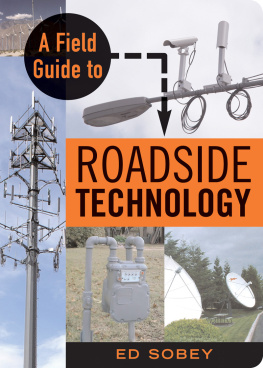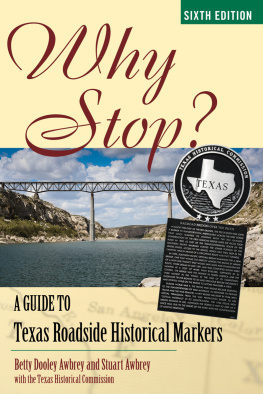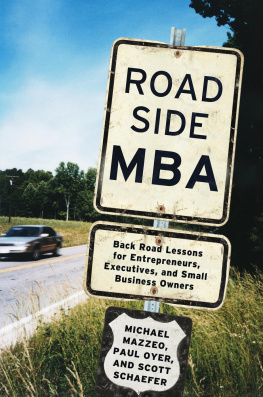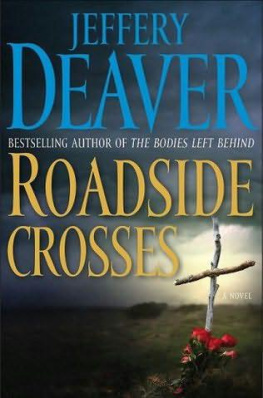
Library of Congress Cataloging-in-Publication Data
Sobey, Edwin J. C., 1948
A field guide to roadside technology / Ed Sobey. 1st ed.
p. cm.
Includes bibliographical references and index.
ISBN 1-55652-609-1
1. RoadsAccessories. 2. Traffic signs and signals.
3. Electronic apparatus and appliances. I. Title.
TE228.S63 2006
625.79dc22
2006002979
Cover and interior design: Joan Sommers
Photo credits: page , Xcel Energy Corporation. All rights reserved.
2006 by Ed Sobey
All rights reserved
First edition
Published by Chicago Review Press, Incorporated
814 North Franklin Street
Chicago, Illinois 60610
ISBN-13: 978-1-55652-609-1
ISBN-10: 1-55652-609-1
Printed in the United States of America
5 4 3 2 1
To Jean and John,
whose curiosity and thirst for adventure have taken them around the world and back home to Oregon.

CONTENTS
ACKNOWLEDGMENTS
WRITING THIS BOOK GAVE ME the opportunity to meet dozens of interesting people and to learn how stuff works. I enjoyed learning from the experts and I thank them all.
Glenn Kuhn graciously answered my questions about cellular telephone service and antennas, and he reviewed that part of the text. Thanks, Glenn.
John Weigant, nautical authority, helped me with aids to navigation. He even let me steer his sailboat. Thats trust.
Marie Wise, who is with the Port of Longview, Washington, enthusiastically provided photographs of ships and port operations. She took the photograph of the Ocean Rainbow and sent the photograph of the Rubin Kobe log carrier, which was taken by Jan Fardell.
Ed Trigg, inventor and entrepreneur, provided photographs of and information on his microwave overheight vehicle detector.
Nelson Monroe, Water Operations Supervisor for the City of Redmond, Washington, guided me through his citys water system and toured me through pump stations, tanks, and wells. Wastewater is a different department, and for that I turned to Denise Chanez with the Wastewater Treatment Division of King County, Washington. Vern Allemand, Waste-water Crew Chief for the City of Snoqualmie, Washington, gave me a tour of that citys new treatment plant and explained its operation.
Jim Deal of Crowley Marine arranged for me to join the Chief, one of the companys tugboats, so I could get photographs of ships and marine terminals in Seattle. Richard Schwab of Verizon guided me through the maze of wires that make up the telephone system, from central office to home.
Woody Ross, a retired Puget Sound Energy lineman, led me from the Snoqualmie Falls hydroelectric facility to the home wall outlet, explaining how the electrical distribution system works. My friend from Ohio, Guy Pipitone, provided photographs and explanations of electrical generating plants. Jim Maloney, with the Eugene Water & Electric Board in Eugene, Oregon, steered me to information on wind generation of electricity. William Skaff offered advice on differentiating nuclear power plants from fossil fuel plants.
One of my running routes takes me past a fish wheel on Bear Creek. Taking my camera one day to get a photograph of the wheel, I happened to meet fisheries biologist Lindsey Fleischer. She showed me how the wheel works and how salmon are tagged. Luis A. Fuste, Information Officer with the U. S. Geological Service (USGS), provided information on stream gauging stations.
Several people contributed photographs. The beautiful shot of the Golden Gate Bridge came from Art Mayoff. Automatic Lightning Protection provided the photograph of lightning rods. Carol DiQuilio of Reef Industries sent me the photograph of the aerial survey marker.
Randy Stegemeyer of Port Orchard, Washington, provided information on antennas in general and on radio telescope antennas in particular. He also provided a photograph of his radio telescope.
Greg Leege with the Washington State Department of Transportation provided the photograph of the highway advisory radio and explained to me how it worked. Matthew Van Valkenburgh, Director of the Fresno Yosemite International Airport, helped me get photographs from the airport and answered my questions.
Several friends who run with me contributed in several places. Steve McCracken helped me unravel some of the mysteries of the telephone system. Mary Ann Olson and Ryan Olson gave me additional guidance on traffic devices and vehicles.
Keith Berisford of ATT Broadband took me on a tour of a cable system in Redmond, Washington, and Kirkland, Washington, and answered my many questionsthanks, Keith. A chance encounter along the road resulted in my gaining additional clarification about the cable system thanks to Sean Collins.
Mike Whiteaker of the Bellevue, Washington, Traffic Engineering Department guided me through the labyrinth of information regarding traffic signals. Candy Masters helped me with traffic counters. Mike and Candys boss, Dirk Mitchell, was kind enough to let them spend time with me.
Pat Culbert, Director of Media Relations for Xcel Energy, provided photographs of cooling towers. Rose M. Sabijon and Tanya Cooper of the National Petrochemical & Refiners Association provided the photograph of the refinery. Derek Locke provided the photograph of the cow standing on the cantilever bridge. Nice shot, Derek.
Jordan Thompson provided me great help in figuring out the wireless Internet.
First Calls Uplink provided me with the photograph of its uplink truck. Bill Evans of TowerKill.com told me about the effectiveness of bird deflectors.
Peggy Laramie, American Gas Association Director of Public Relations, gave me information on gas transportation systems. Jodi Wright and Cathy Reynolds of Pacific Northwest Natural Gas identified the gas regulator that I photographed on the outskirts of Astoria, Oregon. Thank you, ladies.
Albert Alvareztorres Jr., with the American Radio Relay League, identified the ham radio antenna found in the photo in this book and provided information about it.
Dave Steele, Washington State Surveyor, provided great photographs of survey markers and border monuments, and he wrote up a summary of monuments for me. Dean Dan Bartell at California State University, Fresno, helped me identify irrigation systems in photographs. Professor Bill Dornfeld reviewed the manuscript and offered helpful suggestions for improving it.
Many of the photographs were taken by Rich Sidwa, and I am deeply thankful for his help.
Obviously, many people contributed to the writing of this book. I extend a hearty thank you to each of you.
INTRODUCTION
AS YOU WALK AROUND your neighborhood you see machines that work for you, but you may not know what they do. However, if one of them breaks or has to be replaced, you certainly notice the interruption in service. Your water may be shut off for a few hours. You might lose phone service, electrical power, or the cable signal for your television. When that thing on the utility pole or on the ground breaks, you realize how important it is to you. A Field Guide to Roadside Technology will help you figure out what that thing is and how it works. Some field guides help you identify birds or trees you see. This book identifies devices made by people.
A Field Guide to Roadside Technology will help you be a technology detective. You can find out which of your neighbors has cable television. You can figure out what the tangle of wires is on a utility pole, or what a particular antenna is for. You can look at a ship and quickly figure out what type it is and what functions it performs.
Next page














